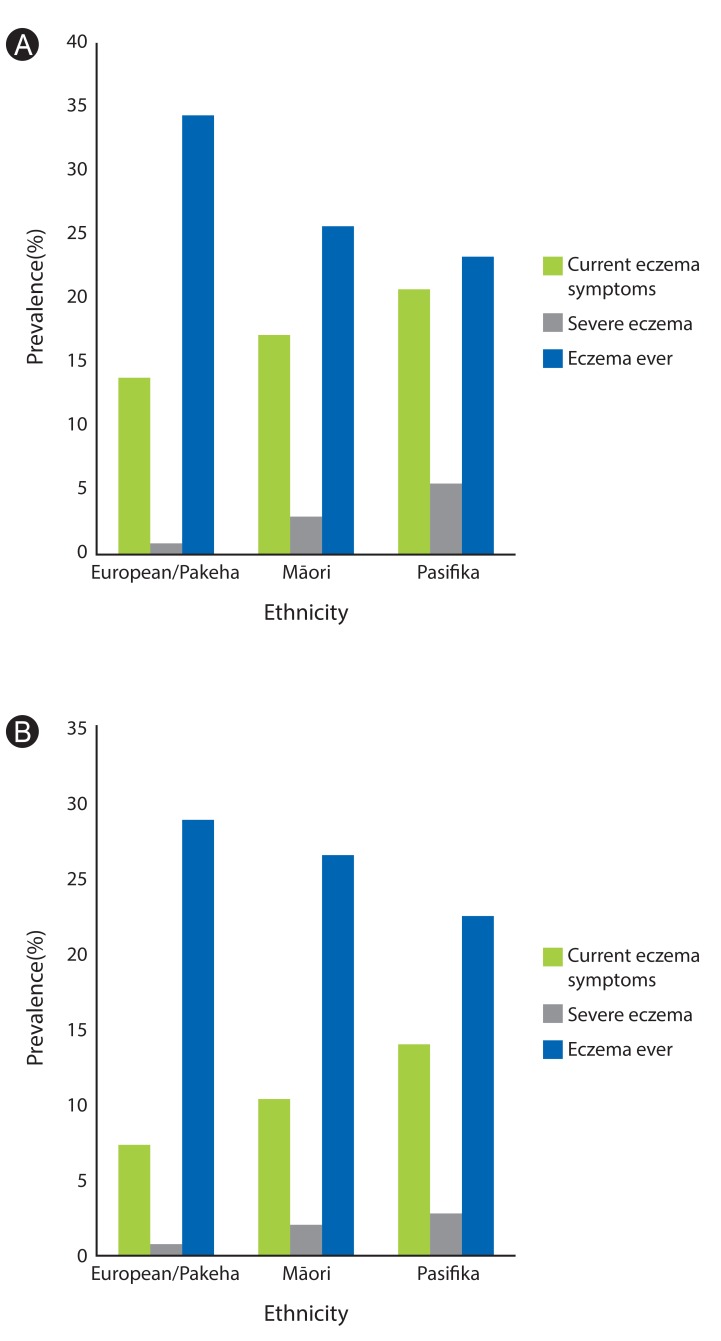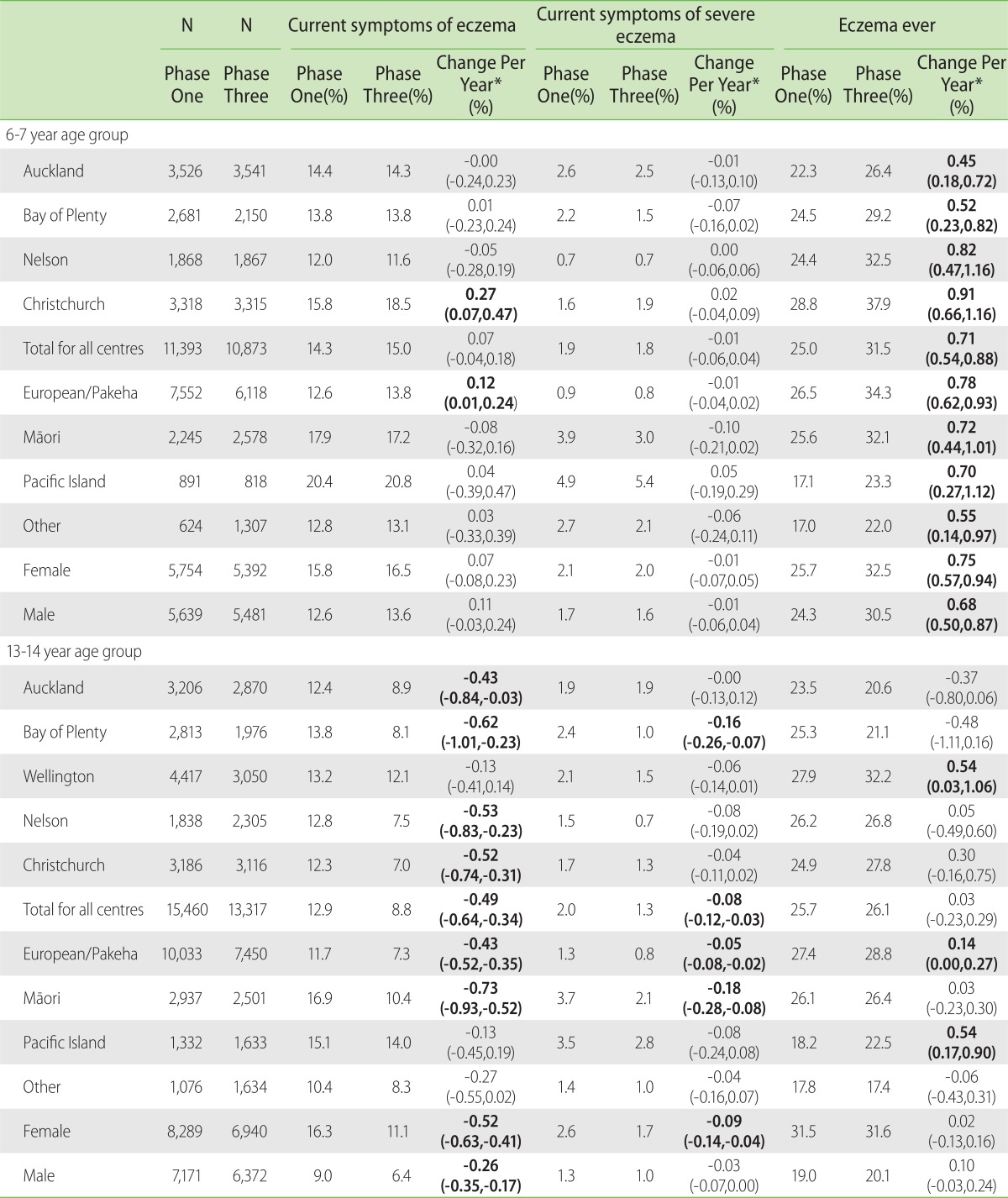1. Johansson SG, Bieber T, Dahl R, Friedmann PS, Lanier BQ, Lockey RF, Motala C, Ortega Martell JA, Platts-Mills TA, Ring J, Thien F, Van Cauwenberge P, Williams HC. Revised nomenclature for allergy for global use: report of the Nomenclature Review Committee of the World Allergy Organization, October 2003. J Allergy Clin Immunol. 2004; 113:832–836. PMID:
15131563.

2. Friedmann PS, Ardern-Jones MR, Holden CA. Atopic dermatitis. In : Burns T, Breathnach S, Cox N, Griffiths C, editors. Rook's textbook of dermatology. 8th ed. Hoboken (NJ): Wiley-Blackwell;2010. p. 24.
3. Rycroft RJ, Robertson SJ, Wakelin SH. Colour handbook of dermatology. 2nd ed. London: Manson Publishing Ltd;2010.
4. Graham-Brown RA. Atopic dermatitis: predictions, expectations, and outcomes. J Am Acad Dermatol. 2001; 45:S61–S63. PMID:
11423878.

5. Williams HC, Strachan DP. The natural history of childhood eczema: observations from the British 1958 birth cohort study. Br J Dermatol. 1998; 139:834–839. PMID:
9892950.

6. Fivenson D, Arnold RJ, Kaniecki DJ, Cohen JL, Frech F, Finlay AY. The effect of atopic dermatitis on total burden of illness and quality of life on adults and children in a large managed care organization. J Manag Care Pharm. 2002; 8:333–342. PMID:
14613399.

7. Basra MK, Shahrukh M. Burden of skin diseases. Expert Rev Pharmacoecon Outcomes Res. 2009; 9:271–283. PMID:
19527100.

8. ISAAC Steering Committee. International Study of Asthma and Allergies in Childhood Manual. Auckland/Münster: ISAAC Steering Committee;1993.
9. Asher MI, Keil U, Anderson HR, Beasley R, Crane J, Martinez F, Mitchell EA, Pearce N, Sibbald B, Stewart AW, Strachan D, Weiland SK, Williams HC. International Study of Asthma and Allergies in Childhood (ISAAC): rationale and methods. Eur Respir J. 1995; 8:483–491. PMID:
7789502.

10. Williams H, Robertson C, Stewart A, Aït-Khaled N, Anabwani G, Anderson R, Asher I, Beasley R, Björkstén B, Burr M, Clayton T, Crane J, Ellwood P, Keil U, Lai C, Mallol J, Martinez F, Mitchell E, Montefort S, Pearce N, Shah J, Sibbald B, Strachan D, von Mutius E, Weiland SK. Worldwide variations in the prevalence of symptoms of atopic eczema in the International Study of Asthma and Allergies in Childhood. J Allergy Clin Immunol. 1999; 103:125–138. PMID:
9893196.

11. Asher MI, Barry D, Clayton T, Crane J, D'Souza W, Ellwood P, Ford RP, Mackay R, Mitchell EA, Moyes C, Pattemore P, Pearce N, Stewart AW. The burden of symptoms of asthma, allergic rhinoconjunctivitis and atopic eczema in children and adolescents in six New Zealand centres: ISAAC Phase One. N Z Med J. 2001; 114:114–120. PMID:
11346157.
12. Flohr C, Weinmayr G, Weiland SK, Addo-Yobo E, Annesi-Maesano I, Björkstén B, Bråbäck L, Büchele G, Chico M, Cooper P, Clausen M, El Sharif N, Martinez Gimeno A, Mathur RS, von Mutius E, Morales Suarez-Varela M, Pearce N, Svabe V, Wong GW, Yu M, Zhong NS, Williams HC. ISAAC Phase Two Study Group. How well do questionnaires perform compared with physical examination in detecting flexural eczema? Findings from the International Study of Asthma and Allergies in Childhood (ISAAC) Phase Two. Br J Dermatol. 2009; 161:846–853. PMID:
19485999.

13. Ellwood P, Asher MI, Beasley R, Clayton TO, Stewart AW. ISAAC Steering Committee. The international study of asthma and allergies in childhood (ISAAC): Phase Three rationale and methods. Int J Tuberc Lung Dis. 2005; 9:10–16. PMID:
15675544.
14. Asher MI, Montefort S, Björkstén B, Lai CK, Strachan DP, Weiland SK, Williams H. ISAAC Phase Three Study Group. Worldwide time trends in the prevalence of symptoms of asthma, allergic rhinoconjunctivitis, and eczema in childhood: ISAAC Phases One and Three repeat multicountry cross-sectional surveys. Lancet. 2006; 368:733–743. PMID:
16935684.

15. Pattemore PK, Ellison-Loschmann L, Asher MI, Barry DM, Clayton TO, Crane J, D'Souza WJ, Ellwood P, Ford RP, Mackay RJ, Mitchell EA, Moyes C, Pearce N, Stewart AW. Asthma prevalence in European, Maori, and Pacific children in New Zealand: ISAAC study. Pediatr Pulmonol. 2004; 37:433–442. PMID:
15095327.

16. Ellison-Loschmann L, Pattemore PK, Asher MI, Clayton TO, Crane J, Ellwood P, Mackay RJ, Mitchell EA, Moyes C, Pearce N, Stewart AW. Ethnic differences in time trends in asthma prevalence in New Zealand: ISAAC Phases I and III. Int J Tuberc Lung Dis. 2009; 13:775–782. PMID:
19460256.
17. Ellwood P, Asher MI, Stewart AW. ISAAC Phase III Study Group. The impact of the method of consent on response rates in the ISAAC time trends study. Int J Tuberc Lung Dis. 2010; 14:1059–1065. PMID:
20626953.
18. Odhiambo JA, Williams HC, Clayton TO, Robertson CF, Asher MI. ISAAC Phase Three Study Group. Global variations in prevalence of eczema symptoms in children from ISAAC Phase Three. J Allergy Clin Immunol. 2009; 124:1251–1258.e23. PMID:
20004783.

19. Craig E, Jackson C, Han D. NZCYES Steering Committee. Monitoring the health of New Zealand children and young people: indicator handbook. Auckland: Paediatric Society of New Zealand and the New Zealand Child and Youth Epidemiology Service;2007.
20. Dale MC, O'Brien M, St John S, editors. Left further behind: how policies fail the poorest children in New Zealand. Auckland: Child Poverty Action Group;2011.
21. Schäfer T. Epidemiology of atopic eczema. In : Ring J, Przybilla B, Ruzicka T, editors. Handbook of atopic eczema. 2nd ed. New York (NY): Springer;2006. p. 21–30.
22. Cohet C, Cheng S, MacDonald C, Baker M, Foliaki S, Huntington N, Douwes J, Pearce N. Infections, medication use, and the prevalence of symptoms of asthma, rhinitis, and eczema in childhood. J Epidemiol Community Health. 2004; 58:852–857. PMID:
15365112.

23. Purvis DJ, Thompson JM, Clark PM, Robinson E, Black PN, Wild CJ, Mitchell EA. Risk factors for atopic dermatitis in New Zealand children at 3.5 years of age. Br J Dermatol. 2005; 152:742–749. PMID:
15840107.

24. Fergusson DM, Horwood LJ, Shannon FT. Risk factors in childhood eczema. J Epidemiol Community Health. 1982; 36:118–122. PMID:
6896887.

25. Silvers KM, Frampton CM, Wickens K, Epton MJ, Pattemore PK, Ingham T, Fishwick D, Crane J, Town GI. New Zealand Asthma and Allergy Cohort Study Group. Breastfeeding protects against adverse respiratory outcomes at 15 months of age. Matern Child Nutr. 2009; 5:243–250. PMID:
20572927.

26. Fergusson DM, Horwood LJ, Shannon FT. Parental asthma, parental eczema and asthma and eczema in early childhood. J Chronic Dis. 1983; 36:517–524. PMID:
6874883.

27. Waite DA, Eyles EF, Tonkin SL, O'Donnell TV. Asthma prevalence in Tokelauan children in two environments. Clin Allergy. 1980; 10:71–75. PMID:
7363447.

28. Kemp T, Pearce N, Fitzharris P, Crane J, Fergusson D, St George I, Wickens K, Beasley R. Is infant immunization a risk factor for childhood asthma or allergy? Epidemiology. 1997; 8:678–680. PMID:
9345669.

29. Marcon A, Cazzoletti L, Rava M, Gisondi P, Pironi V, Ricci P, de Marco R. Incidence of respiratory and allergic symptoms in Italian and immigrant children. Respir Med. 2011; 105:204–210. PMID:
20934316.

30. Robertson CF, Williams H, Ellwood P, Garcia-Marcos L, Anderson HR, Wong GW. Asthma and migration: unmasking asthma potential. The International Study of Asthma and Allergy in Childhood (ISAAC) Phase Three. In : Society International Conference; 2010 May 14-19; New Orleans, LA. New York (NY): American Thoracic Society;2010. –A6796.
31. Brunekreef B, Stewart AW, Anderson HR, Lai CK, Strachan DP, Pearce N. ISAAC Phase Three Study Group. Self-reported truck traffic on the street of residence and symptoms of asthma and allergic disease: a global relationship in ISAAC Phase Three. Environ Health Perspect. 2009; 117:1791–1798. PMID:
20049134.
32. Krämer U, Sugiri D, Ranft U, Krutmann J, von Berg A, Berdel D, Behrendt H, Kuhlbusch T, Hochadel M, Wichmann HE, Heinrich J. GINIplus and LISAplus study groups. Eczema, respiratory allergies, and traffic-related air pollution in birth cohorts from small-town areas. J Dermatol Sci. 2009; 56:99–105. PMID:
19713084.

33. Lee YL, Su HJ, Sheu HM, Yu HS, Guo YL. Traffic-related air pollution, climate, and prevalence of eczema in Taiwanese school children. J Invest Dermatol. 2008; 128:2412–2420. PMID:
18449213.

34. Montnemery P, Nihlén U, Göran Löfdahl C, Nyberg P, Svensson A. Prevalence of self-reported eczema in relation to living environment, socio-economic status and respiratory symptoms assessed in a questionnaire study. BMC Dermatol. 2003; 3:4. PMID:
12859793.

35. Brown SJ, McLean WH. Eczema genetics: current state of knowledge and future goals. J Invest Dermatol. 2009; 129:543–552. PMID:
19209157.

36. O'Regan GM, Irvine AD. The role of filaggrin in the atopic diathesis. Clin Exp Allergy. 2010; 40:965–972. PMID:
20642575.




 PDF
PDF ePub
ePub Citation
Citation Print
Print




 XML Download
XML Download